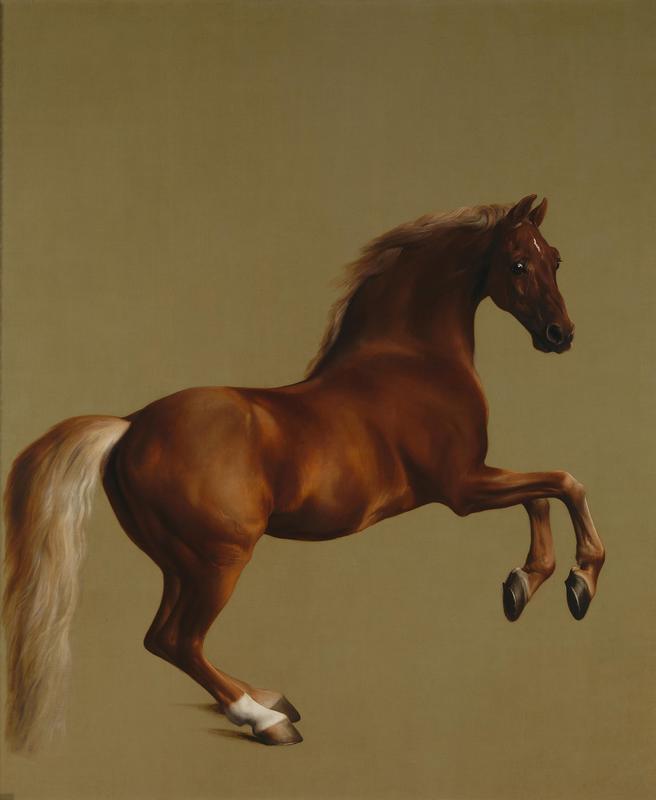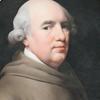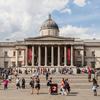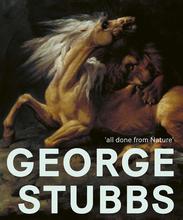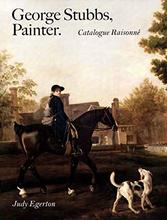More about Whistlejacket
- All
- Info
- Shop

Contributor
Everybody’s pissed about how everything is politicized these days, like can’t we even look at a painting of a horse without talking about representation?
But nobody got mad when people read politics into this painting of a horse in the 18th century, so all this P.C. anxiety seems like a them problem.
The rumor goes that the patron, the Marquess of Rockingham, had intended for Whistlejacket to be a royal equestrian portrait featuring his highness George III. But then the Marquess and Georgie had a lil falling out and Stubbs was ordered to leave the background and horseback blank. Seems like you wouldn’t go through all that trouble to paint the horses back if the plan was to stick a mad king that lost America on there later, but that’s just me.
The real story here is that this 9 ft by 8 ft painting which looks like a racehorse trading card is actually, universally beloved to this day. Like you know the horse girls are going to be all about it, but the rest of the world, too? Whistlejacket is cited as the stud for such famous horses as the equus ferus in Guernica, and if Picasso is a secret brony, I guess we are too.
Yes, adoration is valid. Sure it’s just a horse but Stubbs’ obsessive knowledge of horse anatomy gives ye olde Whistlejacket the breath of life. And it is a very pretty horse. And his eyes are wild and fearful and peer into the depths of your soul, begging the question of whether freedom is just a word we invented to make ourselves feel powerful.
As for the painting as a democratic metaphor: it was given to the National Gallery on indefinite loan from an actual descendant of the Marquess of Rockingham. The democracy of images. Art is ungovernable! ANARCHY! WHISTLEJACKET HATES THE RULING CLASS AND SO SHOULD YOU! We still have an economic oligarchy, sure, but at least we can look at pretty paintings.
Sources
- Berkery, Kristen. April 14, 2011. “whistlejacket, the $18 million horse.” I Love Horses, 2015. Accessed January 31, 2018. http://ilovehorses.net/history-2/whistlejacket-the-18-million-horse/
- Graham-Dixon, Andrew. June 7, 1996. “Stubbs’s equine masterpiece puts animal passion into the National.” The Independent. Accessed January 31, 2018. https://www.independent.co.uk/news/stubbss-equine-masterpiece-puts-anim…
- Jones, Jonathan. April 22, 2000. “ Whistlejacket, George Stubbs (1762).” The Guardian, 2018. Accessed January 31, 2018 .https://www.theguardian.com/culture/2000/apr/22/art1
- Leinhard, John H. 1994. “No. 906: George Stubbs’s Anatomy.” Engines of Our Ingenuity, 1997. Accessed January 31, 2018. https://www.uh.edu/engines/epi906.htm
- Royal Household at Buckingham Palace. “George III (r. 1760–1820).” The home of the Royal Family. Accessed January 31, 2018. https://www.royal.uk/george-iii-r-1760-1820
Featured Content
Here is what Wikipedia says about Whistlejacket
Whistlejacket is an oil-on-canvas painting from about 1762 by the British artist George Stubbs showing the Marquess of Rockingham's racehorse approximately at life-size, rearing up against a plain background. The canvas is large, lacking any other content except some discreet shadows, and Stubbs has paid precise attention to the details of the horse's appearance. It has been described in The Independent as "a paradigm of the flawless beauty of an Arabian thoroughbred". The Fitzwilliam family, heirs of the childless Rockingham, retained the painting until 1997 when funding from the Heritage Lottery Fund allowed the National Gallery, London to acquire it for £11 million.
Stubbs was a specialist equine artist who in 1762 was invited by Rockingham to spend "some months" at Wentworth Woodhouse in Yorkshire, his main country house. Stubbs had painted many horse portraits, with and without human figures, but the heroic scale and lack of background of Whistlejacket are "unprecedented" in his work and equine portraits in general and "contemporaries were so astonished that a single horse should command a huge canvas that legends quickly developed" explaining why the painting was unfinished, none of which seem plausible or supported by the evidence to modern art historians. In fact Stubbs's earliest canvases on his visit in 1762 included a pair of much smaller paintings of groups of standing horses, one including Whistlejacket, in a horizontal format "like a classical frieze" with a similar honey beige background broken only by small shadows at the feet. It would seem likely that leaving the portraits without the usual landscape background was Rockingham's idea.
Stubbs depicts Whistlejacket rising to a levade, but with his head turned towards the viewer, in a pose comparable to a number of earlier monumental equestrian portraits, including examples by Rubens and Velázquez, but in these the emphasis is on the rider. Here the horse is alone and in a natural state, producing a "romantic study in solitude and liberty". Like many of Stubbs's other paintings of horses and other animals in the wild, including several versions of a horse attacked by a lion perched on its back, the painting is an early intimation of Romanticism, as well as a challenge to the lowly place animal painting occupied in the hierarchy of genres.
To a greater degree than any earlier painter, Stubbs produced genuinely individual portraits of specific horses, paying intimate attention to details of their form. Minute blemishes, veins, and the muscles flexing just below the surface of the skin are all visible and reproduced with great care and realism. Whistlejacket had already retired after a fairly successful racing career, but was painted in this unusual form to show "a supremely beautiful specimen of the pure-bred Arabian horse at its finest".
Check out the full Wikipedia article about Whistlejacket

